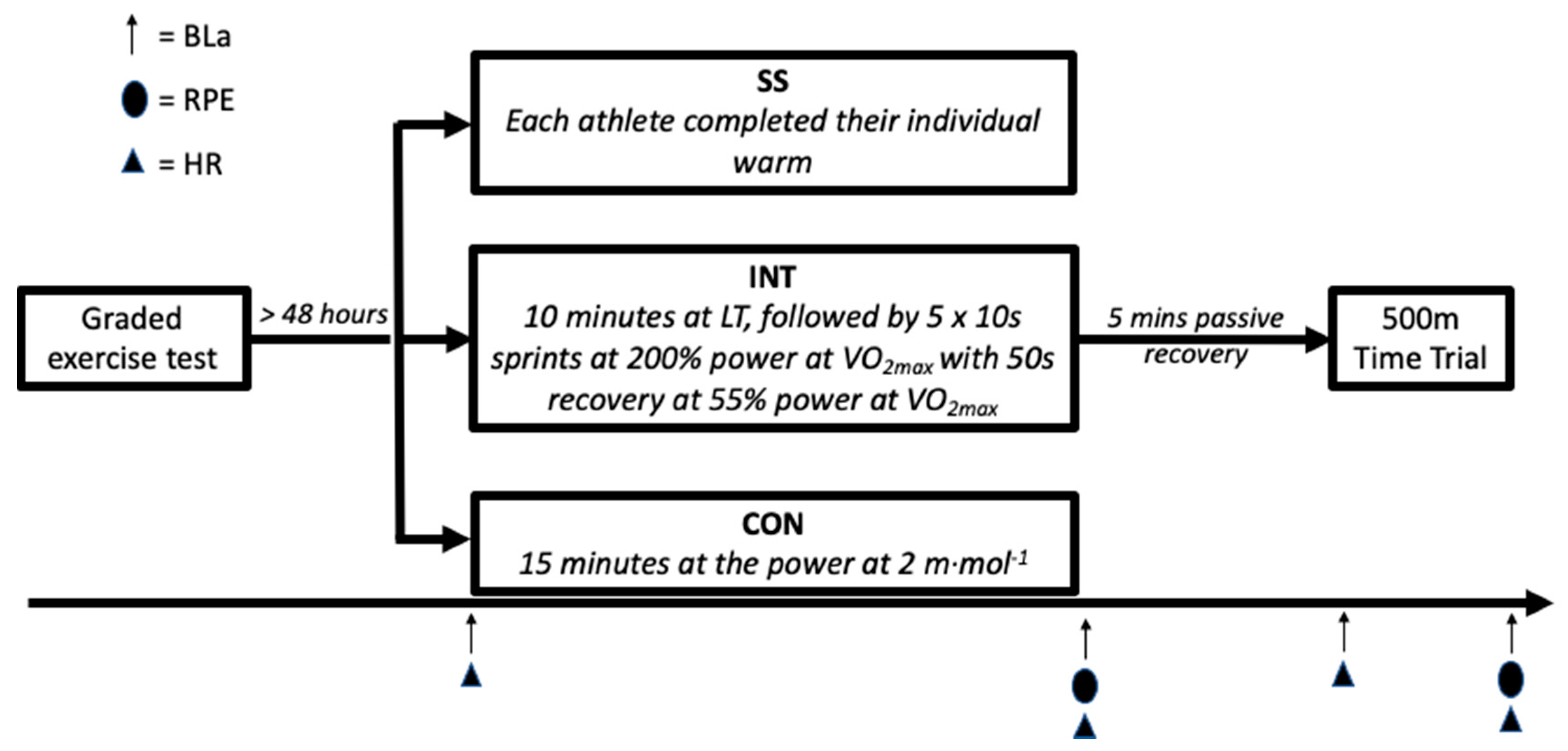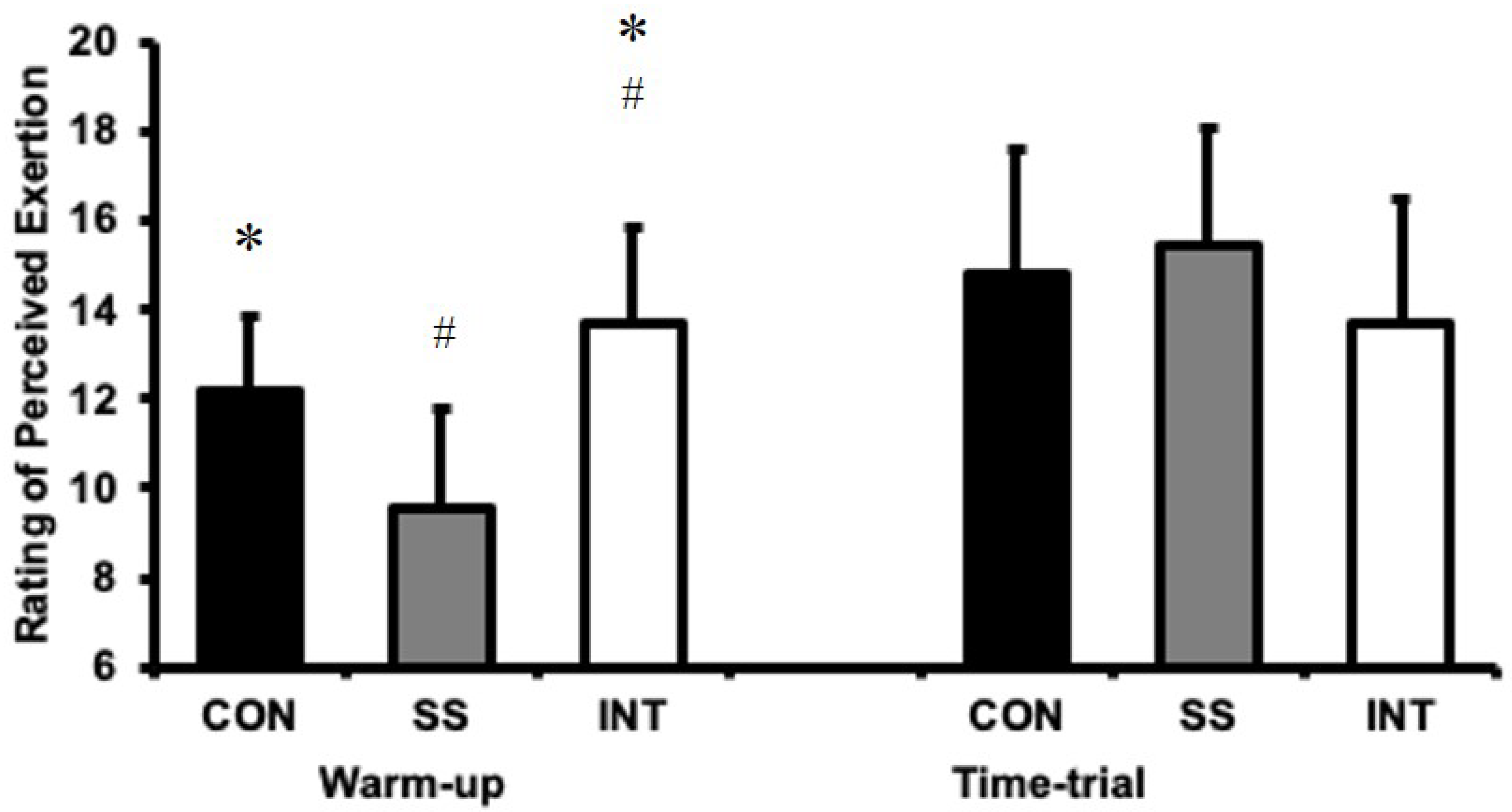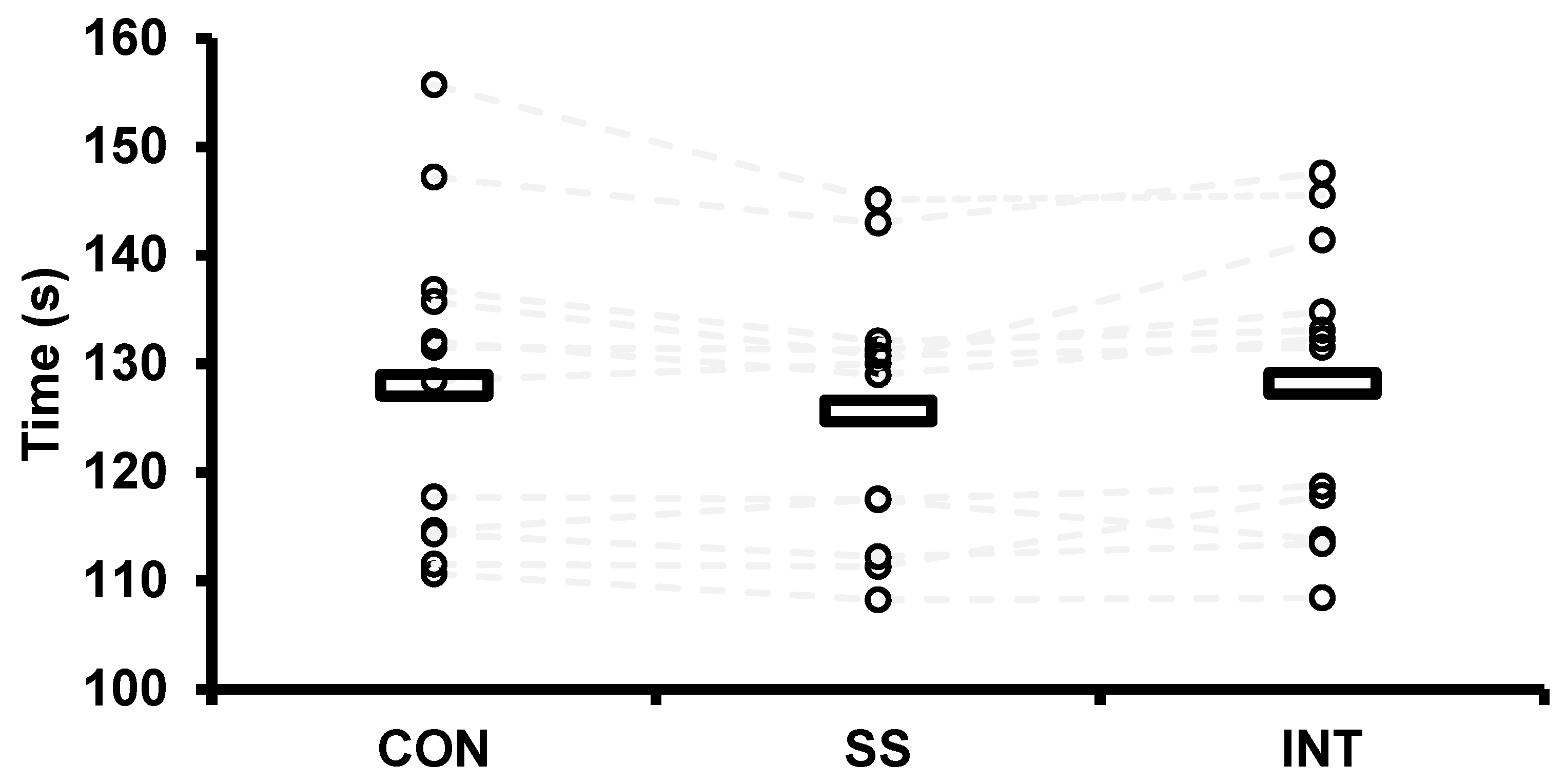Self-Selected Versus Standardised Warm-Ups; Physiological Response on 500 m Sprint Kayak Performance
Abstract
1. Introduction
2. Materials and Methods
2.1. Participants
2.2. Experimental Design
2.3. Procedures
2.3.1. Lactate Threshold and Maximal Oxygen Uptake
2.3.2. Warm-Up Procedures
- Self-selected: Participants completed a ~15 min SS warm-up that they would typically complete prior to competition. The full details of these warmups can be found in Table 1.
2.4. Time Trial Performance
2.5. Statistical Analysis
3. Results
3.1. Internal Load during the Warm-Up
3.2. Time Trial Performance
3.3. Internal Load during the Time Trial
4. Discussion
5. Conclusions
Author Contributions
Funding
Acknowledgments
Conflicts of Interest
References
- Bishop, D.; Bonetti, D.; Dawson, B. The influence of pacing strategy on VO2 and supramaximal kayak performance. Med. Sci. Sports Exerc. 2002, 34, 1041–1047. [Google Scholar] [CrossRef] [PubMed]
- ICF. 2019 ICF Canoe Sprint World Chamionships. Available online: https://www.canoeicf.com/canoe-sprint-world-championships/szeged-2019 (accessed on 6 July 2020).
- Baker, J. Biomechanics of paddling. In Proceedings of the 30th Conference of the International Society of Biomechanics in Sports (ISBS), Melbourne, Australia, 2–6 July 2012; pp. 101–104. [Google Scholar]
- Baudouin, A.; Hawkins, D. A biomechanical review of factors affecting rowing performance: Commentary. Br. J. Sports Med. 2002, 36, 402. [Google Scholar] [CrossRef] [PubMed]
- Bishop, D. Physiological predictors of flat-water kayak performance in women. Eur. J. Appl. Physiol. 2000, 82, 91–97. [Google Scholar] [CrossRef] [PubMed]
- van Someren, K.A.; Howatson, G. Prediction of flatwater kayaking performance. Int. J. Sports Physiol. Perform. 2008, 3, 207–218. [Google Scholar] [CrossRef] [PubMed]
- Zouhal, H.; Le Douairon Lahaye, S.; Ben Abderrahaman, A.; Minter, G.; Herbez, R.; Castagna, C. Energy system contribution to Olympic distances in flat water kayaking (500 and 1000 m) in highly trained subjects. J. Strength Cond. Res. 2012, 26, 825–831. [Google Scholar] [CrossRef] [PubMed]
- Borges, T.O.; Bullock, N.; Coutts, A.J. Pacing characteristics of international sprint kayak athletes. Int. J. Perform. Anal. Sport 2013, 13, 353–364. [Google Scholar] [CrossRef]
- McKean, M.R.; Burkett, B.J. The influence of upper-body strength on flat-water sprint kayak performance in elite athletes. Int. J. Sports Physiol. Perform. 2014, 9, 707–714. [Google Scholar] [CrossRef]
- Aitken, D.A.; Jenkins, D.G. Anthropometric-based selection and sprint kayak training in children. J. Sports Sci. 1998, 16, 539–543. [Google Scholar] [CrossRef]
- Bonetti, D.L.; Hopkins, W.G.; Kilding, A.E. High-intensity kayak performance after adaptation to intermittent hypoxia. Int. J. Sports Physiol. Perform. 2006, 1, 246–260. [Google Scholar] [CrossRef]
- Liow, D.K.; Hopkins, W.G. Velocity specificity of weight training for kayak sprint performance. Med. Sci. Sports Exerc. 2003, 35, 1232–1237. [Google Scholar] [CrossRef]
- Kilduff, L.P.; Finn, C.V.; Baker, J.S.; Cook, C.J.; West, D.J. Preconditioning strategies to enhance physical performance on the day of competition. Int. J. Sports Physiol. Perform. 2013, 8, 677–681. [Google Scholar] [CrossRef] [PubMed]
- Burnley, M.; Doust, J.H.; Jones, A.M. Effects of prior warm-up regime on severe-intensity cycling performance. Med. Sci. Sports Exerc. 2005, 37, 838–845. [Google Scholar] [CrossRef] [PubMed]
- Stewart, I.B.; Sleivert, G.G. The effect of warm-up intensity on range of motion and anaerobic performance. J. Orthop. Sports Phys. Ther. 1998, 27, 154–161. [Google Scholar] [CrossRef] [PubMed][Green Version]
- Bishop, D.; Bonetti, D.; Spencer, M. The effect of an intermittent, high-intensity warm-up on supramaximal kayak ergometer performance. J. Sports Sci. 2003, 21, 13–20. [Google Scholar] [CrossRef]
- Balilionis, G.; Nepocatych, S.; Ellis, C.M.; Richardson, M.T.; Neggers, Y.H.; Bishop, P.A. Effects of different types of warm-up on swimming performance, reaction time, and dive distance. J. Strength Cond. Res. 2012, 26, 3297–3303. [Google Scholar] [CrossRef]
- Fairbank, M.; Highton, J.; Twist, C. Passive heat maintenance after an initial warm-up improves high-intensity activity during an interchange rugby league movement simulation protocol. J. Strength Cond. Res. 2019, 00, 1–6. [Google Scholar] [CrossRef]
- Bishop, D. Warm up I: Potential mechanisms and the effects of passive warm up on exercise performance. Sports Med. 2003, 33, 439–454. [Google Scholar] [CrossRef]
- Bishop, D. Warm up II: Performance changes following active warm up and how to structure the warm up. Sports Med. 2003, 33, 483–498. [Google Scholar] [CrossRef]
- Bishop, D.; Bonetti, D.; Dawson, B. The effect of three different warm-up intensities on kayak ergometer performance. Med. Sci. Sports Exerc. 2001, 33, 1026–1032. [Google Scholar] [CrossRef]
- Burkett, L.N.; Phillips, W.T.; Ziuraitis, J. The best warm-up for the vertical jump in college-age athletic men. J. Strength Cond. Res. 2005, 19, 673–676. [Google Scholar]
- Mandengue, S.H.; Seck, D.; Bishop, D.; Cissé, F.; Tsala-Mbala, P.; Ahmaidi, S. Are athletes able to self-select their optimal warm up? J. Sci. Med. Sport 2005, 8, 26–34. [Google Scholar] [CrossRef]
- Tanner, R.; Gore, C.J. Physiological Tests for Elite Athletes, 2nd ed.; Human Kinetics: Champaign, IL, USA, 2013. [Google Scholar]
- Alanazi, H.M. Role of warming-up in promoting athletes health and skills. Int. J. Sci. Res. Publ. 2016, 6, 156. [Google Scholar]
- Lok, L.Y. Biomechanics study in sprint kayaking using simulator and on-water measurement instrumentation: An overview. In Proceedings of the 3rd Malaysian Postgraduate Conference, Sydney, Australia, 4–5 July 2013; pp. 216–233. [Google Scholar]
- Dankel, S.J.; Mouser, J.G.; Mattocks, K.T.; Counts, B.R.; Jessee, M.B.; Buckner, S.L.; Loprinzi, P.D.; Loenneke, J.P. The widespread misuse of effect sizes. J. Sci. Med. Sport 2017, 20, 446–450. [Google Scholar] [CrossRef] [PubMed]
- Hopkins, W.G.; Marshall, S.W.; Batterham, A.M.; Hanin, J. Progressive statistics for studies in sports medicine and exercise science. Med. Sci. Sports Exerc. 2009, 41, 3–12. [Google Scholar] [CrossRef]
- Rezk, C.C.; Marrache, R.C.B.; Tinucci, T.; Mion, D.; Forjaz, C.L.M. Post-resistance exercise hypotension, hemodynamics, and heart rate variability: Influence of exercise intensity. Eur. J. Appl. Physiol. 2006, 98, 105–112. [Google Scholar] [CrossRef]
- de Morree, H.M.; Klein, C.; Marcora, S.M. Perception of effort reflects central motor command during movement execution. Psychophysiology 2012, 49, 1242–1253. [Google Scholar] [CrossRef]
- van Someren, K.A.; Phillips, G.R.; Palmer, G.S. Comparison of physiological responses to open water kayaking and kayak ergometry. Int. J. Sports Med. 2000, 21, 200–204. [Google Scholar] [CrossRef]



| Participant | Ranking | Age | Mass (kg) | Stature (cm) | VO2max (mL·kg·min−1) | Warm up |
|---|---|---|---|---|---|---|
| 1 | Men’s B | 21 | 79 | 181 | 42 | 500 m relaxed paddle, 3–4 × 20 stroke efforts |
| 2 | Women’s B | 18 | 75 | 186 | 32 | 250 m relaxed paddle, power strokes 250 m, 3–5 × 30 stroke build up (10, 10, 10), 250m paddle, 1 × 30 stroke rolling start, 1 × 30 strokes standing start |
| 3 | Boys B | 15 | 56 | 179 | 39 | 500 m relaxed paddle, 2 × standing starts, 2 × 40 stroke build-up of power same stroke rate upping every 10 until max on 40, 2 × standing starts. |
| 4 | Boys C | 15 | 72 | 181 | 43 | 750 m paddle with power strokes on/off, 200 m paddle, 3 × 30 stroke starts. |
| 5 | Men’s B | 20 | 76 | 180 | 39 | 90 s relaxed paddle, 3 × 30 at 70% PM rolling starts, 3 × 20 at 80% PM rolling starts, 2 × 20 at 90% PM, 1 rolling start and 1 standing start, 1 × 15 at 100% PM standing start. |
| 6 | Boys B | 16 | 77 | 182 | 55 | 3 × 30 strokes at 70% PM, 2 × 20 strokes at 80% PM, 1 × 20 strokes at 90% PM, 1 × 20 strokes at 95% PM. |
| 7 | Boys A | 16 | 51 | 165 | 65 | 500 m relaxed paddle, 3 × 30 strokes at 70% PM, 2 × 20 strokes at 80% PM, 2 × 20 strokes at 90% PM, 1 × 20 strokes at 100% PM, 2 build ups (10 strokes 70% PM, 10 strokes 80% PM, 10 strokes 90% PM, 5 strokes at 100% PM. |
| 8 | Men’s A | 20 | 86 | 183 | 46 | 500 m relaxed paddle, 3 × 30 strokes at 70% PM, 20 strokes at 80% PM, 20 strokes at 80–90% PM, 10 strokes at 60% PM. |
| 9 | Girls A | 18 | 59 | 160 | 36 | 500 m perceived LT threshold paddle, 3 × 30 strokes at 70% PM, 2 × 20 strokes at 80% PM, 1 × 20 strokes at 90% PM, 2–3 standing starts × 40 strokes. |
| 10 | Men’s A | 21 | 79 | 179 | 50 | 3 × 30 strokes at 70% PM, 2 × 20 strokes at 80% PM, 1 × 20 strokes at 90% PM, 1 × 30 strokes at 70% PM, 1 × 20 strokes at 95% PM, 1 × 30 strokes at 70% PM. |
| 11 | Girls C | 15 | 61 | 171 | 38 | 2 × 30 strokes at 70% PM, 2 × 25 strokes at 80% PM, 2 × 15 strokes at 95% PM, 2 × standing starts. |
| 12 | Boys C | 17 | 59 | 174 | 48 | 500 m relaxed paddle, 3 × 30 strokes at 70% PM, 2 × 20 strokes at 80% PM, 2 × 20 strokes at 90% PM, 1 × 20 strokes at 100% PM, 2 build ups (10 strokes at 70% PM, 10 strokes at 80% PM, 10 strokes at 90% PM, 5 strokes at 100% PM. |
| Pre | Post | ||
|---|---|---|---|
| CON | BLa (mmol·L−1) | 1.1 ± 0.2 | 2.0 ± 0.6 * |
| Heart rate (BPM) | 63.7 ± 3.5 | 108.6 ± 18.8 * | |
| SS | BLa (mmol·L−1) | 1.1 ± 0.2 | 1.8 ± 1.3 |
| Heart rate (BPM) | 66.1 ± 12.0 | 96.7 ± 9.4 * | |
| INT | BLa (mmol·L−1) | 1.1 ± 0.3 | 3.3 ± 1.6 * |
| Heart rate (BPM) | 67.2 ± 8.8 | 107.7 ± 18.2 * |
| Pre | Post | ||
|---|---|---|---|
| CON | BLa (mmol·L−1) | 1.9 ± 0.5 | 6.0 ± 2.1 * |
| Heart rate (BPM) | 102.4 ± 16.1 | 131.2 ±19.1 * | |
| SS | BLa (mmol·L−1) | 1.7 ± 1.4 | 7.1 ± 2.3 * |
| Heart rate (BPM) | 95.8 ± 13.1 | 136.4 ± 19.4 * | |
| INT | BLa (mmol·L−1) | 3.2 ± 1.6 | 6.9 ± 2.3 * |
| Heart rate (BPM) | 100.4 ± 21.5 | 122.1 ± 20.7 * |
Publisher’s Note: MDPI stays neutral with regard to jurisdictional claims in published maps and institutional affiliations. |
© 2020 by the authors. Licensee MDPI, Basel, Switzerland. This article is an open access article distributed under the terms and conditions of the Creative Commons Attribution (CC BY) license (http://creativecommons.org/licenses/by/4.0/).
Share and Cite
Dingley, A.F.; Willmott, A.P.; Fernandes, J.F.T. Self-Selected Versus Standardised Warm-Ups; Physiological Response on 500 m Sprint Kayak Performance. Sports 2020, 8, 156. https://doi.org/10.3390/sports8120156
Dingley AF, Willmott AP, Fernandes JFT. Self-Selected Versus Standardised Warm-Ups; Physiological Response on 500 m Sprint Kayak Performance. Sports. 2020; 8(12):156. https://doi.org/10.3390/sports8120156
Chicago/Turabian StyleDingley, Amelia F., Alexander P. Willmott, and John F. T. Fernandes. 2020. "Self-Selected Versus Standardised Warm-Ups; Physiological Response on 500 m Sprint Kayak Performance" Sports 8, no. 12: 156. https://doi.org/10.3390/sports8120156
APA StyleDingley, A. F., Willmott, A. P., & Fernandes, J. F. T. (2020). Self-Selected Versus Standardised Warm-Ups; Physiological Response on 500 m Sprint Kayak Performance. Sports, 8(12), 156. https://doi.org/10.3390/sports8120156






